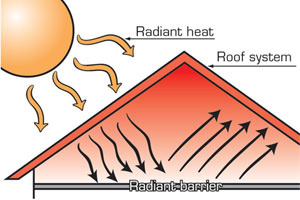Consumers in warm U.S. climates use significant amounts of electricity to cool their houses. And the price of electricity dramatically has increased because of higher costs to produce it and short supply. In response to these problems, government agencies are looking for ways to conserve energy by improving houses' energy efficiency. One approach some states are advocating is the use of radiant barriers.
Studies by the Florida Solar Energy Center (FSEC) have shown cooling costs can be reduced if houses use radiant barriers. However, NRCA has some concerns about the effects radiant barriers may have on roof assemblies.
Heat transfer

How the principles of heat transfer apply to a house |
Radiant barriers work according to the principles of heat transfer. Heat transfer is when heat moves from a warm area to a cold area. There are three modes of heat transfer: conduction, convection and radiation.
Conduction occurs when two objects are in contact and heat directly moves from one object to the other. Convection happens when heat is transferred through a gas or liquid. Radiation occurs when heat travels as an energy wave in a straight path; the energy wave heats any object it contacts along its path.
Installation
There are many radiant barrier products available to consumers. Following are the most familiar products:
- Foil sheets (aluminized plastic films)—Foil sheets are laminated to a backing material, such as polypropylene, kraft paper or polyethylene.
- Foil-faced roof sheathing—Oriented strand board or plywood sheets are laminated with foil on one side.
The U.S. Department of Energy (DOE) and Oak Ridge National Laboratory (ORNL), Oak Ridge, Tenn., offer a fact sheet about radiant barriers on ORNL's Web site. The fact sheet contains consumer information and installation recommendations. In general, the recommended placement for radiant barriers is under a roof deck. If using foil sheets, the sheets should be draped between rafters or trusses to create an air space. Foil sheets also can be placed on top of attic floor insulation; however, dust and dirt can accumulate on them and eventually impair their performance. In all cases, the reflective side should face the attic space. The same applies to foil-faced roof sheathing; the reflective side should be facing down toward the attic.
It also is important to note the Reflective Insulation Manufacturers Association (RIMA) and ORNL advise that a radiant barrier will be most effective if used in an attic that is properly ventilated and has the appropriate amount of insulation.
Effects on a roof
A concern when using radiant barriers is possible detrimental effects on roofing materials. RIMA conducted a study about the effects of a radiant barrier on roofing materials, specifically asphalt shingles. The results showed the installation of a radiant barrier increased shingle temperature by 2 degrees Fahrenheit (1 degree Celsius) to 5 degrees Fahrenheit (3 degrees Celsius).
In 2002, RIMA issued these results in a technical bulletin, TB103, and stated the use of radiant barriers should not reduce asphalt shingle life. The bulletin also contains a list of roofing material manufacturers that claim their warranties will not be affected by installing radiant barriers. The bulletin can be found in the technical information section on RIMA's Web site.
NRCA's position
NRCA does not recommend the use of radiant barriers in roof assemblies. The FSEC study showed the use of radiant barriers increases the temperature of roofing materials and roof decks. Although a several degree increase does not sound excessive, higher temperatures increase the potential for premature aging of roofing materials.
Consumers who use radiant barriers should be aware they may be reducing the service lives of their roof assemblies as a trade-off for reduced energy bills.
Joan P. Crowe is an NRCA manager of technical services.

